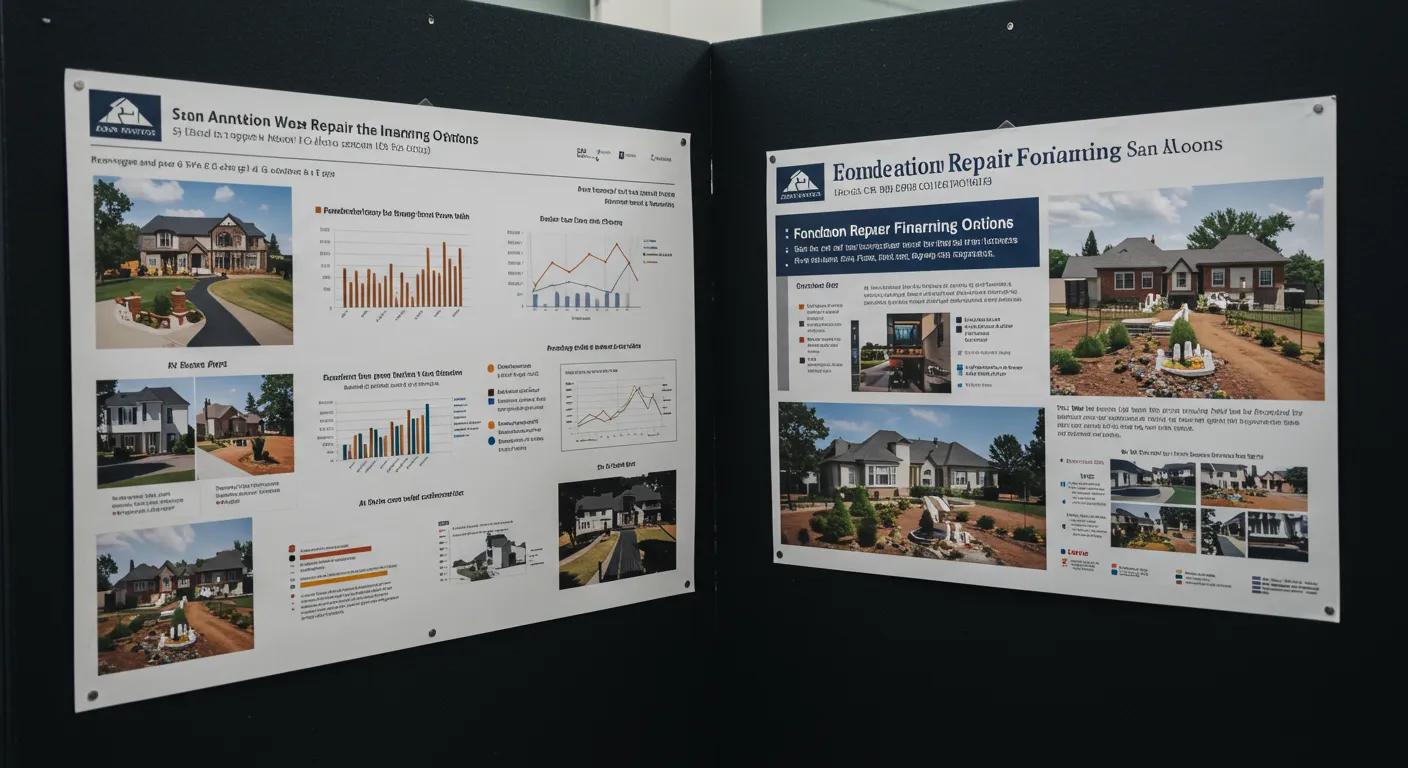Navigating FoundationRepairFinancing in San Antonio: What Are Your Options?
Foundationrepair issues can become overwhelming for Texas homeowners when cracks, shifting walls, or uneven floors threaten safety and value. In addition to repairing the foundation, finding affordable financing options that work with one’s budget and timeline is a major challenge. This article reviews various financing solutions available in San Antonio for foundationrepair—from personal loans and home equity lines of credit to in-house financing, credit cards, and insurance considerations. Homeowners will learn how to qualify for these options and which factors influence loan terms and rates, helping them make informed decisions that reduce financial stress and ensure long-term stability while addressing issues like soil erosion and expansive clay.
In the sections below, we break down common financing solutions for foundation repairs, explain how to qualify for loans, compare rates, and secure favorable terms. We also highlight local financing options provided by San Antonio banks, credit unions, and repair companies. This guide delivers actionable strategies and real-world examples to empower property owners to address repair projects with confidence and financial clarity.
Best Foundation Repair Financing Options in San AntonioFoundationRepairFinancing Solutions in San Antonio
Homeowners in San Antonio face high repair costs, making it essential to understand the financing options available. Whether it is through personal loans, home equity lines of credit (HELOC), direct in-house financing, or even credit cards, each option offers distinct benefits and challenges when managing repair expenses alongside foundation work.
Exploring Personal Loans for Your San Antonio Foundation Project
Personal loans are accessible and usually do not require collateral, making them a popular option for smaller repair jobs. They often come with fixed interest rates and repayment terms of two to five years, allowing for predictable monthly payments. For example, a homeowner needing around $10,000 for minor foundation settling might secure a personal loan at about a 6% interest rate over three years. Applicants must typically provide proof of income, credit history, and sometimes repair estimates from licensed contractors. Comparing multiple quotes is crucial to ensuring that the loan structure fits the repair timeline. Additionally, personal loans can cover related expenses like waterproofing and soil remediation.
Utilizing Home Equity Loans or Lines of Credit for Repairs
Home equity loans and HELOCs take advantage of the existing equity in the property, often offering lower interest rates compared to personal loans. These products are ideal for large, long-term repair investments. A home equity loan provides a lump sum payment, while a HELOC offers flexibility to withdraw funds as needed. With interest rates as low as 4% to 5% and repayment terms extending from 10 to 20 years, these options can help finance extensive repairs such as structural reinforcements or addressing expansive clay issues. The application process may involve an appraisal and verification of current market values, making a home equity product well suited for substantial, multi-phase repair projects.
Considering in-House Financing From San Antonio Repair Companies
Some foundationrepair companies offer in-house financing as part of their service packages, streamlining the process by integrating financing directly with the repair contract. This option can simplify paperwork by providing one point of contact and may include features like deferred payments or low-interest promotional rates. In-house financing is particularly useful when repairs involve several stages, such as soil stabilization, slab repairs, and waterproofing. Homeowners should inquire about the full cost, including any fees or interest amounts, to ensure the financing terms align with their overall budget.
Assessing Credit Cards for Smaller FoundationRepair Costs
Credit cards offer convenience and flexibility when covering smaller repair expenses, particularly for jobs under $2,000. They can be a practical solution for emergency fixes, such as addressing minor cracks or localized water damage. Some cards offer introductory 0% APR periods; however, homeowners must be cautious to pay off the balance within the promotional period to avoid high-interest charges. This option is best for covering costs while awaiting approval for larger loans or more extensive financing options.
Investigating Homeowners Insurance Coverage for Foundation Damage
Typically, homeowners insurance does not cover foundation repairs unless damage results from specific hazards, such as flooding or earthquakes. It is important to review policy details and speak with an insurance agent to understand any limited coverage available. In some cases, endorsements or additional riders can be purchased that provide broader protection. Detailed documentation—including inspection reports and repair estimates—is often required for any claim, and periodic reassessment of the policy is recommended after noticing signs of foundation movement.
How to Qualify for FoundationRepairFinancing in San Antonio

Securing financing for foundation repairs involves careful preparation and understanding lender requirements. Lenders evaluate factors such as credit score, financial stability, and the estimated cost of repairs to determine eligibility.
Checking Your Credit Score and Report for Loan Eligibility
Credit scores significantly influence the interest rate and loan amount. Lenders usually prefer scores above 650, although those with lower scores may still be approved at higher interest rates. Homeowners should review their credit reports for accuracy, dispute any errors, and work to improve their credit by reducing outstanding debts before applying for a loan.
Gathering Necessary Documentation for Your Application
A complete application typically requires recent pay stubs, tax returns, proof of residence, detailed repair estimates from licensed contractors, and a current mortgage statement. Organizing these documents in advance demonstrates financial responsibility and can expedite the approval process. In some cases, an appraisal of the property may also be necessary.
Understanding Lender Requirements in the San Antonio Area
Local banks, credit unions, and online lenders may have different criteria for foundationrepair loans. San Antonio lenders often consider the severity of foundation issues, regional market conditions, and the overall condition of the home. Specific requirements may include a higher loan-to-value ratio for major repairs. Homeowners should contact local institutions to obtain detailed information about minimum credit scores, income thresholds, and collateral requirements.
Improving Your Chances of Loan Approval
Homeowners can improve their approval odds by resolving credit report discrepancies, increasing emergency savings, and reducing new credit inquiries. Collecting multiple repair estimates from reputable contractors not only strengthens an application but also demonstrates that the repair plan is well researched. Taking the time to compare various financing options—sometimes through pre-qualification processes that do not impact credit scores—can further increase the likelihood of favorable loan terms.
Key Factors Influencing FoundationRepairFinancing Terms in San Antonio
Understanding the key factors that influence financing terms helps homeowners make better decisions when securing a loan for foundationrepair.
How the Extent of Foundation Damage Impacts Loan Amounts
The severity of foundation damage directly affects the approved loan amount. Minor issues may require loans ranging between $5,000 and $10,000, whereas significant structural problems can necessitate financing of $30,000 to $50,000 or more. Lenders base their decisions on professional repair estimates to determine both repair costs and the available property equity used as collateral.
The Role of Your Creditworthiness in Securing Favorable Rates
Credit history is instrumental in determining interest rates; higher credit scores typically yield lower rates and better repayment terms. For example, a score of 750 might secure an interest rate around 4.5%, while a score closer to 650 could result in rates above 7%. Maintaining a low debt-to-income ratio and consistent credit history will not only improve rates but may also provide access to larger loan amounts.
Comparing Interest Rates and Loan Terms From Different Lenders
It is important to compare offers from various lenders, including traditional banks, credit unions, and online institutions. Homeowners should evaluate secured versus unsecured loan options, considering factors such as interest rates, fees, repayment terms, and the total cost over the loan’s lifetime. Even small differences in interest rates can lead to significant overall savings. Using tools like spreadsheets or online loan calculators can help in making data-driven decisions.
Understanding Secured Versus Unsecured Loan Options
Secured loans, such as home equity loans and HELOCs, typically offer lower interest rates because they require collateral. In contrast, unsecured personal loans do not require collateral but generally carry higher interest rates due to additional lender risk. Homeowners must weigh the benefits of lower rates against the risk of using their property as collateral and decide which option best suits their specific repair needs and financial situation.
Specific Financing Avenues and Programs for San Antonio Residents

San Antonio offers several specialized financing avenues and programs tailored to the needs of local homeowners facing foundation repairs. These programs are designed to address the challenges posed by Texas soil conditions, including expansive clay.
Identifying San Antonio Contractors Offering Payment Plans
Many foundationrepair companies in San Antonio now include in-house payment plans as part of their service offerings. These plans might feature deferred payments, low down payments, or even no-interest installment options. By bundling financing with the repair contract, homeowners can simplify the payment process and reduce upfront costs. It is important to review proposals carefully and check customer reviews to ensure reliability.
Researching Local San Antonio Banks and Credit Unions for Loans
Local financial institutions, such as San Antonio banks and credit unions, often provide competitive rates and personalized service for foundationrepairfinancing. These institutions may offer flexible qualification criteria adjusted to the local market conditions. Homeowners should obtain and compare multiple quotes to assess not only interest rates but also fees, repayment schedules, and any special programs aimed at home improvement or disaster recovery.
Exploring Potential Government Assistance or Grant Opportunities in Texas
Some government programs and grants may be available to help fund critical foundation repairs, especially in high-risk areas. Although these grants might not cover all costs, they can reduce the overall financial burden when combined with private financing. Homeowners should check with local government agencies or state housing departments for current eligibility criteria and program details.
“Fund at Closing” Options When Selling Your San Antonio Home
An innovative financingoption involves incorporating repair costs into the home-selling process through “fund at closing” arrangements. In this scenario, repair funds are disbursed directly to certified contractors during the closing process, ensuring that foundation issues are remedied before ownership is transferred. This strategy can benefit both sellers, who may receive a higher sale price once repairs are completed, and buyers who acquire a home with a stable foundation.
Table: Comparison of Financing Options in San Antonio
The table above provides a side-by-side comparison of common financing options, helping homeowners narrow down which financing mechanism best aligns with their needs and financial situation.
Making the Right Choice for Your San Antonio FoundationRepairFinancing
Selecting the right financing method is critical for both the current repair work and the homeowner’s long-term financial health. It is essential to carefully compare multiple financing quotes, examine all contract details, and choose a plan that aligns with both repair timelines and overall financial goals.
Comparing Multiple Financing Quotes and Offers
Homeowners should actively compare offers from banks, credit unions, private lenders, and repair companies offering in-house financing. Key factors include total financing costs, repayment durations, monthly payment amounts, and any penalties for early repayment. Using an online loan calculator or spreadsheet can help quantify the long-term implications of different loan options.
Reading the Fine Print Before Committing to a Loan
Before finalizing any loan, homeowners must read the fine print to understand all aspects of the financing agreement. Key details to check include interest rate fluctuations, late fees, and prepayment penalties. If anything is unclear, consulting a financial advisor or attorney can help avoid future complications and ensure that the terms match the homeowner’s budget and repair schedule.
Seeking Advice From Financial Advisors if Needed
A financial advisor can offer valuable insights when navigating complex financing options for foundationrepair. Their advice can help match the best financingoption with the homeowner’s broader financial strategy. By reviewing all financial liabilities and obligations—from existing mortgages to credit card debts—advisors can recommend plans that enhance approval odds and optimize repayment schedules.
Aligning the Financing Plan With Your Budget and Repair Timeline
The chosen financing plan should integrate smoothly with the homeowner’s overall budget and the repair timeline. Assessing how much can be realistically allocated toward repairs and matching the loan term to expected repair milestones are critical steps. This balanced approach helps avoid overextending financially while ensuring that repairs are executed promptly and effectively.
Alternatives and Additional Support for San Antonio Foundation Repairs

Beyond traditional financing, several alternative resources can further ease the financial burden of foundation repairs. Exploring non-traditional programs, phased repair methods, and community resources can help manage costs effectively.
Seeking Non-Profit Assistance Programs in the San Antonio Area
Several non-profit organizations in San Antonio offer emergency financial assistance or low-cost repair services for homeowners facing critical repairs. These programs often target economically challenged households and can provide grants or subsidized loans that help bridge funding gaps while preventing safety hazards.
Understanding Disaster Recovery Grants if Applicable
In the event of natural disasters or severe weather events, some disaster recovery grants may offer temporary relief for foundation repairs. Although these grants are generally designed for broader property damage, they can sometimes extend to foundation issues. Homeowners should check with local government agencies or emergency management offices to determine eligibility and application requirements.
Phasing Repairs to Manage Costs Over Time
When repair costs are high, homeowners might consider phasing the work over time. A phased approach allows critical issues to be addressed immediately while postponing less urgent repairs until additional funds become available. This strategy can help spread the financial burden and is particularly effective when combined with flexible financing options like HELOCs.
The Importance of Addressing Foundation Issues Promptly to Avoid Higher Costs
Delaying foundation repairs can lead to worsening damage and higher overall repair costs. Early intervention not only helps maintain property value but also improves eligibility for better financing terms. Addressing issues promptly can reduce the risk of emergency repairs that often come with premium rates and extensive work.
List: Advantages of Addressing Foundation Issues Promptly
- Lower RepairCosts – Early repairs may prevent more extensive, costly work later.
- Improved Loan Terms – Addressing issues promptly can lead to better financing options.
- Preservation of Property Value – Timely repairs help maintain market value.
- Prevention of Further Damage – Fixing minor issues stops them from escalating.
- Enhanced Safety – Immediate repairs reinforce the home’s structural integrity.
Frequently Asked Questions
Q: How do I determine which financingoptionis best for my foundationrepair? A: The optimal option depends on the extent of the damage, your credit score, and your financial situation. Compare interest rates, repayment terms, and fees across personal loans, home equity products, in-house financing, and credit card options. Consulting with financial advisors and repair experts can help identify the most suitable option.
Q: What affects the interest rates on foundationrepairfinancing? A: Interest rates are influenced by creditworthiness, the type of loan (secured vs. unsecured), local market conditions, and the severity of the repair project. Home equity loans generally offer lower rates due to the collateral involved.
Q: Can I combine different financingoptions for my repairproject? A: Yes. Homeowners frequently combine options—for example, using a personal loan for immediate expenses and a HELOC for more extensive repairs—to take advantage of competitive rates while managing smaller costs flexibly.
Q: Are there special loan programs for foundationrepairs available in SanAntonio? A: Some local banks, credit unions, and foundation repair companies offer specialized financing programs with features such as in-house financing and tailored payment plans that address urgent repairs and phased payment needs.
Q: Does homeownersinsurance ever cover foundationrepaircosts? A: Typically, standard homeowners insurance does not cover foundation repairs unless the damage results from specific risks like flooding or earthquakes. It is advisable to review your policy details or consider additional endorsements for broader coverage.
Q: What steps can I take to improve my chances of loan approval for foundationrepairfinancing? A: Improve your credit score by resolving inaccuracies, reduce outstanding debts, gather comprehensive documentation including repair estimates, and compare multiple financing offers. Consulting a financial advisor can also strengthen your application.
Final Thoughts
Addressing foundationrepair issues in San Antonio requires aligning financing options with both the scale of repairs and the homeowner’s financial profile. By comparing personal loans, home equity products, in-house financing, and credit card solutions, homeowners can secure competitive terms that alleviate stress and ensure timely repairs. Proactive measures—such as verifying credit reports, assembling detailed documentation, and seeking professional advice—are key to successful financing. Ultimately, making informed choices now helps safeguard the home’s structural integrity and market value while managing repair costs effectively.

